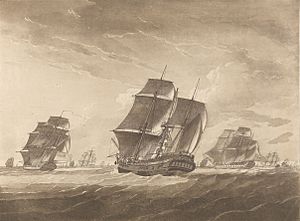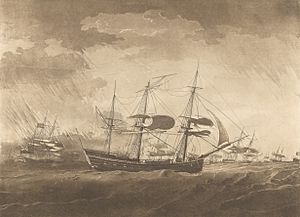Lady Juliana (1777 ship) facts for kids

Robert Dodd: Lady Juliana in tow of the Pallas Frigate. The Sailors Fishing the main Mast which was shatter'd by Lightning.
|
|
Quick facts for kids History |
|
|---|---|
| Name | Lady Juliana |
| Builder | Stephenson & Co, Whitby |
| Launched | 1777, or 1778 |
| Fate | Last listed in Lloyd's Register in 1829. |
| General characteristics | |
| Class and type | Barque |
| Tons burthen | 379, or 380, or 401, or 500 (bm) |
| Length | 110 feet |
| Beam | 40 feet |
| Armament | 20 × 6-pounder guns |
| Notes | Three masts and two decks |
The Lady Juliana (also known as the Lady Julian) was a ship launched in Whitby, England, in 1777. She became famous for transporting female convicts from England to Australia in 1789.
Contents
A Long Journey to Australia
The British government hired Lady Juliana to carry female convicts to the new colony in Australia. Lieutenant Thomas Edgar, who had sailed with the famous explorer James Cook, was the government's agent on board. The ship's surgeon, Richard Alley, was known for his good care of the people on the ship.
After a six-month delay, Lady Juliana left Plymouth, England, on July 29, 1789. She finally arrived at Port Jackson (which is now Sydney) on June 6, 1790. This journey took 309 days, making it one of the slowest trips for a convict ship. The ship made several stops along the way, including Tenerife, St Jago, Rio de Janeiro, and the Cape of Good Hope.
The ship carried 226 female convicts. Only five of them died during the long voyage. This low number was unusual for such a long trip in those times.
Life on Board
The ship's steward, John Nicol, wrote interesting stories about the journey and the convicts. He noted that the women were sometimes noisy and liked to argue among themselves.
However, the low death rate was mainly thanks to the care provided by Lieutenant Edgar and Surgeon Alley. They made sure that everyone received their proper food rations. The ship was kept clean and aired out regularly. The women were also allowed to spend time on the deck for fresh air. At the ports where the ship stopped, fresh food supplies were brought on board. This kind of care was much better than what many other convict ships provided at the time.
Arrival in a New Colony
When Lady Juliana reached Port Jackson, it was the first ship to arrive there since the First Fleet almost two and a half years earlier. The colony was struggling with a shortage of food. The ship HMS Sirius had also been wrecked, making the situation worse.
Because of the food shortage, the colony's Judge Advocate, David Collins, was surprised to see a ship full of 222 women instead of much-needed food supplies. However, the ship also brought important letters. These letters carried the first news from Europe that the settlement had received since the First Fleet sailed in May 1787.
Two weeks later, a supply ship arrived, followed by three more ships known as the Second Fleet. These ships carried many convicts who were very sick and had been treated poorly. Because Lady Juliana arrived before the main Second Fleet ships, some people consider her part of that fleet, while others do not.
After some repairs, Lady Juliana left Australia on July 25, 1790. She sailed to China to pick up a cargo of tea for the East India Company. The ship returned to England on October 26, 1791.
The Ship's Final Years

The Lady Juliana continued to sail for many years. She was last listed in a shipping record called Lloyd's Register in 1829. At that time, she was trading with the Baltic Sea region. She appeared in another record, the Register of Shipping, in 1832. At that point, her master was Smith, her owner was J. Henly, and she was sailing between Belfast and Quebec.
Notable Women on Board
Several women who traveled on the Lady Juliana became important figures in early Australian history:
- Mary Wade - Mary was only 13 years old when she was transported. When she passed away at age 84, she had around 150 living descendants.
- Elizabeth Steel - Elizabeth is known as the first deaf Australian. Her headstone was found in 1991.
- Mary Pardoe - Mary gave birth to a daughter named Ann in March 1790 during the voyage. Ann's father was Edward Scott, a sailor on the ship. Ann was the youngest person on board when Lady Juliana arrived in Australia.
- Elizabeth Parry - Elizabeth was the first female convict to be set free. She married James Ruse, a farmer who was also a First Fleet convict. Together, they grew the first successful crop in the colony.
- Sarah Dorset - Sarah gave birth to a son named Edward Powell during the journey. The father was also named Edward Powell and was a crew member. After arriving in Sydney, Sarah went to Norfolk Island. There, she had two children with Robert Watson. In 1801, Watson was given land at South Head, in the area now known as Watsons Bay.

